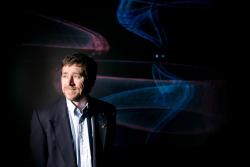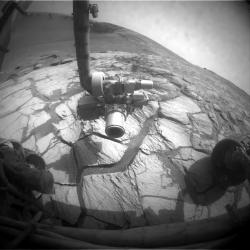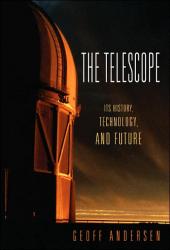Note added in press: The Walker County Observatory recorded its first lunar impact on Sept. 19, 2007.
Sept. 28, 2007: NASA scientists are proving that you can go home again – if you bring a telescope with you. "Home" is north Georgia's Walker County, where astronomers Bill Cooke and Rob Suggs have just set up a research-grade observatory for their old school system.
 Right: Rob Suggs poses by the new lunar impact telescope in Walker County, Georgia.
Right: Rob Suggs poses by the new lunar impact telescope in Walker County, Georgia.
Years ago, they won't say how many, Cooke and Suggs attended the same high school in Walker County and after school they volunteered at the Walker County Science and Technology Center. The center's telescopes fueled their fire for astronomy. They learned to operate the instruments, find their way around the night sky, and they took their first pictures of the Moon.
Now, photographing the Moon is something they do professionally for NASA.
Cooke and Suggs work at the Marshall Space Flight Center in Huntsville, Alabama. Cooke heads up the Meteoroid Environment Office and Suggs leads the Space Environments team. Together with a half-dozen assistants and colleagues, they specialize in "lunar impact monitoring." In other words, they watch meteorites hit the Moon and explode.
"We've recorded about 30 strikes this year so far," says Cooke. Keeping track of these numbers is important to NASA as the agency lays plans to return to the Moon. "We need to know the odds of habitats and spacecraft getting hit."
Which brings us back to Georgia. Installing a telescope in Walker County not only benefits the local Science Center but also it solves a thorny problem for the lunar monitoring team. Cooke explains:
"At our main observatory in Huntsville, we see a fair amount of man-made space junk passing between us and the Moon. If the junk is tumbling and catches sunlight, it looks like an impact flash."
Above: A meteorite hits the Moon--recorded from the MSFC's lunar observatory in Huntsville, Alabama, in May 2006. The Walker County Observatory will soon be detecting similar flashes. [More]
"But suppose you have two observatories separated by some distance—say, one telescope in Alabama and one in Georgia. Then we can tell the difference between a tumbling satellite and a genuine impact. A real impact flash would be seen by both telescopes at the same location on the Moon. A tumbling satellite, on the other hand, will glint differently at the two locations."
Using the internet, NASA will monitor Walker County telescope data remotely ten days each month when the Moon is properly situated for viewing impacts. The Science and Technology Center will use the telescope the rest of the time.
"It opens up a whole new world of potential science fair projects for them," says Cooke.The Meteoroid Office chose this rural county as a home for the telescope because it was a perfect fit. For one thing, Cooke knew that the Science and Technology Center had won a Space Telescope Science Institute grant to help build a new planetarium. "The old planetarium I used as a kid was bull-dozed," says Cooke. "We felt the telescope would be a natural adjunct to the new planetarium."
"The center also has beautifully flat horizons – no trees. It's all clear for viewing. And Rob and I have known the Walker County School District's Science and Technology Coordinator, Wayne Robinson, for years. He can fix the telescope if anything breaks down. It's a win-win situation."
Robinson agrees.
"Having the NASA lunar observatory at our center will pay tremendous dividends for years to come," he says. "Images from the telescope will inspire our students to know more about space science and astronomy. We'll also project the images on to a 40 foot diameter dome, providing audiences with a combination of simulated night sky and real time images. If there ever was a win-win situation, this is it."
 Right: Star cluster M13 photographed by the lunar impact telescope in Walker County. More sample images: Ring Nebula, Lagoon Nebula.
Right: Star cluster M13 photographed by the lunar impact telescope in Walker County. More sample images: Ring Nebula, Lagoon Nebula.
The $15,000 telescope has a 14-inch diameter mirror and will observe from within an 8-foot by 8-foot building with a roll-top roof.
End of story? Not quite. Robinson won't let you go without sharing a tale about Cooke's younger days.
"We used to put on Christmas programs in the old planetarium," recalls Robinson. "I remember one in particular. The planetarium director turned on a black light to reveal wise men and camels. But the black lights revealed something else too. Bill and some other volunteers had secretly placed big signs that said, Wise Men on Strike and Demand Better Camels."
"Needless to say, the event is legendary to this day."
Warning to the next generation: Cooke is back, and he's bringing a telescope with him






























